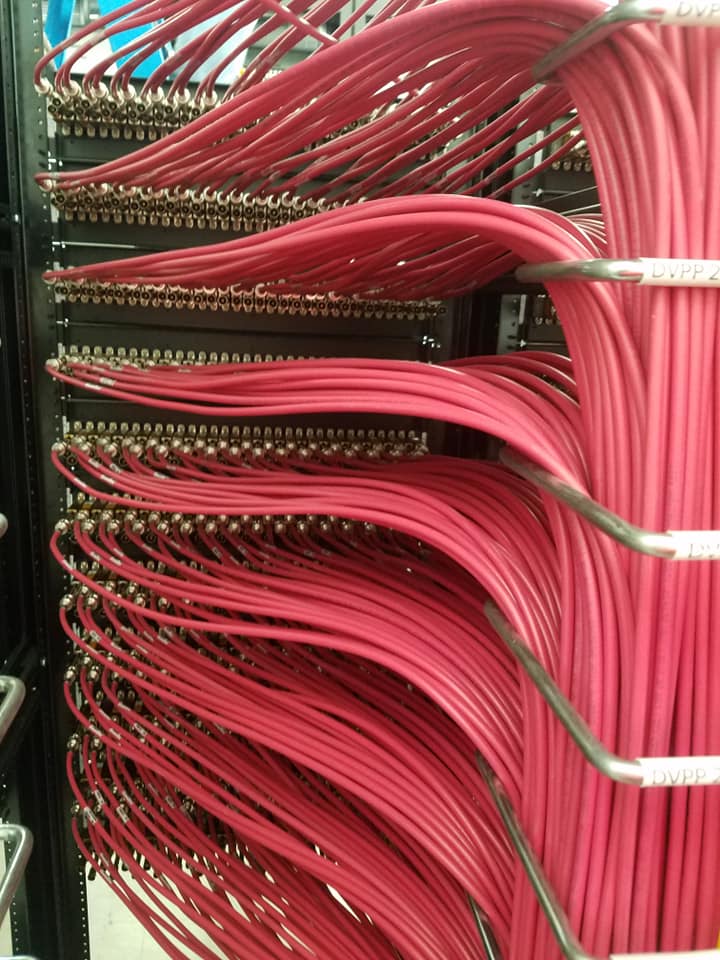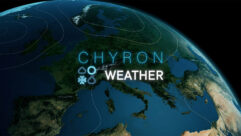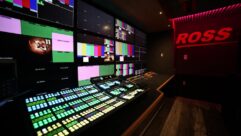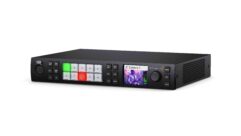On this edition of the SVC Podcast, Contributing Editor Bennett Liles continues his discussion with Paul Nijak of control room and production truck integration firm BeckTV about the new Athletics Broadcast Center that they just completed for the University of Louisville. Paul outlines the staffing and equipment testing in the new facility and he talks about the compressed construction schedule that had the control rooms up and running with custom designed team logos even as other areas were being completed.
Links of Interest:
· The new University of Louisville Athletics Broadcast Center
· BeckTV – Control Room and Broadcast Facility Specialists
· RTS Roameo wireless intercom beltpacks
This is the SVC Podcast from Sound & Video Contractor with Paul Nijak of BeckTV. We’ve got all the show notes and product links for the podcasts at svconline.com. Go to Podcasts at the top of the page.
The University of Louisville’s new Athletics Broadcast Center is up and running ahead of schedule due to the work of control room experts at BeckTV. Now fiber-connected to all of the university’s sports venues, the Broadcast Center is turning out live programming to thrill the Cardinals fans. Senior Engineer Paul Nijak is back with us this week to wrap up the story. Up next on the SVC Podcast.
Good to have you back with us Paul, from BeckTV. Your guys just finished the University of Louisville Athletics Broadcast Center. It was a little bit of a hurry-up. The schedule was pretty tight on it. We’ve talked about the hardware but how do they staff that facility? I think they have four full-time people so I would think maybe students and interns are used for the rest of the positions.
They actually do. Jeremy Noe, the director of the facilities there, he hires people on a per-game basis and it’s not always students. A lot of times students are busy or can’t commit so he’s got a core group of people that he uses in the community, some of which are students and work their way up that he hires on a daily basis. So while we were there, part of what I did towards the end was game support, which once they were on air I worked with his freelancers to train them on the new equipment to make sure that their positions were operating as they should. [Timestamp: 1:38]

That’s great to have a group of local professional freelancers that you can call on to get somebody on sound or video for a game. So after you got it all installed and the fiber connecting everything how long does it take to ring it all out and test to make sure it’s all connected and functioning right or do you test as you go?
On a system this size you really have to do it as you go, so putting a timeline on it is a great question. I’ve never actually done it start to finish – okay, I’m done doing this; let’s test it – because you’re testing it as you go along. If I had to say a certain time I’d say two weeks continuous of testing every wire and doing that. But we start as soon as we put the core in, as soon as we put the router in in this case. It’s an SDI system, baseband, so there’s patch panels. We are testing the router cross points, ins and outs, within 10 days after being on site on typical systems this size. That allows us to first make sure okay, our core or heart of the system is wired correctly. Then from there we move out to the peripherals, all the pieces coming into the system as we start to bring them up online. So for instance all of your graphics and then your switchers. In the University of Louisville they had four video switchers, so we had tested each one of those independently as they got wired and came up online. And then last, but not least, in this system was the intercom and sound, which, to be honest, this system almost had more sound because it was two complete broadcast rooms and then front-of-house support for the different venues, than it did video sources. So sound in this system took quite some time to get faxed out and configured correctly. [Timestamp: 3:21]
And this was a bit of a compressed schedule. I think they actually wanted to get started broadcasting before you even had the place finished.
[Laughs] That’s right. So we were given the facility late due to construction being behind schedule. A few short weeks into the build, Jeremy Noe up there in the university came to me and said that ESPN has come to him and wants him to do the preseason game – and I forget what the sport was. But anyway, they came to him and said we want you to do these early games, and it was about three, maybe four weeks before our delivery date on the system. And so I sat down and we came up with a list of what his requirements were to get that facility on air as for what he was expecting to get out of that show. And I shook his hand and I said I will do whatever it takes to get the agreed-to facilities on the air for you at that date. And sure enough we pulled it off, really without a hitch, to be honest. It was using one of the smaller control rooms that we could get online quickly with its full camera compliment, full intercom and everything ready to go for them. [Timestamp: 4:25]

Nice to have a variety of different studios and control areas because that lets them do several things at once. What exactly are they doing in there now? I know they have live game coverage but I would think they have coaching interviews and things like that.
Yeah. So they have the two primary, what they call the linear broadcast control rooms, that allow them to do two games simultaneously for ESPN on the ACC Network – one linear and one non-linear, however they choose. And then they also have the two other control rooms that allow them to do either a studio show. They also support all the big screens around the campus and the different sports venues so their control rooms can be changed around to control anything individually or independently of each other. I briefly touched on they do have a studio. They have two different sets in there. They have one is a kind of casual sit-down interview set with a set of monitors behind them that can be fed – it’s fed via the router so the switcher can feed it, an aux off the switcher or router feed can feed it. And then there’s more of a traditional news desk-type thing for an update show if they choose to produce one. Inside that studio they have three cameras that are in there full time. [Timestamp: 5:38]
Well, that must be kind of a challenge just keeping straight on who’s doing what when they have several things all going.
It certainly takes someone that’s good at coordinating productions.
And one of the big challenges with this kind of facility is running all the cabling and getting everything connected right. How much cable did you actually have to run?
38.6 miles of cabling is what we have figured up. And that doesn’t include any of the fiber optics; that’s just the cabling within the broadcast facility there on campus. [Timestamp: 6:06]

Those cable runs must have been a pretty big chunk of the construction since it takes a lot of time.
Yeah. Once the facility construction finished up, BeckTV came in and ran all of that wire inside. As integrator, we have a process of specific labeling to keep wires straight and a specific process for quality control on all that. [Timestamp: 6:26]
That’s a marvelous feat when you get all that done and it all actually works with no surprises. That’s a lot of stuff to keep working so who has the regular maintenance on this? After you have it all up and running they can still depend on support from Beck TV for a while.
Some places have contracts in writing of what they expect of us, but at Beck we like to build relationships instead of just jobs. For instance, this job, we have a certain amount of time – I believe it’s one year – that we warranty all of our labor and installation and anything so if a wire is installed wrong and it got pinched or whatever, we would be responsible for replacing that. However, on the other hand, anything that they have problems with, we’re their first line of defense. Their in-house engineer calls me and we talk about what I believe the problem to be and either I can log in remotely and fix it for them, or if it’s above my knowledge we can start to involve the specific manufacturer to get support there for them. [Timestamp: 7:23]

Especially in the initial stages it’s great to know you have ongoing support as you’re getting used to the facility.
Absolutely. As the end user, it’s nice to get a handshake from somebody and know that they’re going to be there not only before the build, during the build, but after the build is over to make sure everything is smooth for you. [Timestamp: 7:40]
As we’re recording this, you’ve already gone ahead with several other projects so what’s Beck TV working on now?
Beck is doing quite a few projects. I’m personally working on Lucas Oil Stadium in Indianapolis; redesign and rebuild of their facility. I’m working on a full broadcast, 53-foot truck for a company, and that’s going to be a complete system design and then buildout. That’s going to be happening early in 2019, so that’s what I personally have going on. And then as a company we have multiple NBC jobs going on. We’re building four different TV stations currently right now around the country. So very busy, very good. [Timestamp: 8:22]

Good way to be. I know you can all be proud to the new broadcast center and I’m sure it’s just a fun place to work even with the pressure of live TV production. I appreciate your comments on it. We’ve been talking to Senior Engineer Paul Nijak with BeckTV and the new University of Louisville Athletics Broadcast Center. Congratulations on a great job.
Thank you. It’s easy to build a good facility when you have clients that know exactly what they want.
OK!
So Cardinals fans have a center for their broadcasts of every sport and BeckTV did the job. Fiber connected to all the University of Louisville sports venues, it’s ready to go. Get back with us next week when we explore another new AV installation project on the next SVC Podcast.










